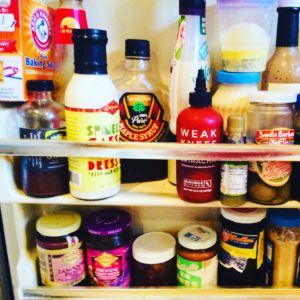 In our fridge, the shelves lining the door are colonized by condiments. Shelf after shelf of condiments. The condiments jostle for limited real estate, obscure their labels behind the plastic railings that corral them into place and rattle a glass-on-glass chorus when the door is opened.
In our fridge, the shelves lining the door are colonized by condiments. Shelf after shelf of condiments. The condiments jostle for limited real estate, obscure their labels behind the plastic railings that corral them into place and rattle a glass-on-glass chorus when the door is opened.
Sound familiar?
The rest of the fridge holds food from 2018. But the condiment shelves are the historical section, a kind of chilled museum featuring artifacts, fossils and oddities—jars of puckered capers, gifty homemade jams bearing faded Christmas stickers, every configuration of salsa from Trader Joe’s, lemongrass paste from a Thai cooking phase, a tin of something with a pig in a bow tie I bought as a souvenir from a trip to Weirdistan.
And let’s not overlook the remnants of condiment dumping—the debris of well-meaning friends who move out of town and “gift” you with their sad and sturdy assortment of relishes, sauces, olives and horseradish. Some we use; some have become science experiments creating molds and aromas fantastical and crippling. And yet they continue to live in our fridge door, ever hopeful, ever rancid.
How many condiments living in the fridge does one household need? If our house were a case study, the answer would be about three dozen.
How many condiments living in the fridge does one household regularly use? If our house were a case study, the answer would be about five.
There are outliers, but most of the condiments in our fridge share a decidedly middle American orientation. The ketchups, the mayos, the mustards. The condiments we reach for the most to add another dimension to whatever we are eating or cooking lean toward the unfrilly, the proletariat. One of my housemates calls herself a two-condiment gal—mayo and ranch dressing are her standards. “Yeah,” she says. “Those two. After all, I’m from the Midwest.”
My friend Dave concocts gastronomical prize winners and calls himself a high-end cook. I call him Mr. Fancy Pants for his condiment collection. His fridge door bulges with a world tour: tandoori paste, jalapeño stuffed olives, chipotle tabasco, chimichurri, biryani paste, green salsa from Belize, Pinot Noir-infused shallot sauté sauce and something handmade in Brooklyn called Weak Knees Gochujang sriracha. He has at least five dozen jars in his fridge door. “They are accessories,” Dave says, insistently. “Condiments are accessories, sometimes exotic accessories, and when I cook, I need to have a lot of them. Pick one or two? I can’t.”
But Dave says his sentimental favorite is Durkee’s Famous Sauce, a mustard-mayo hybrid found in the East and Midwest that was one of his mother’s favorites and held a treasured spot in the fridge when he was growing up.
Condiment taxonomy is relatively simplistic and sifts into four categories: those that are our go-tos, those that mirror some idea of who we want to be as cooks and eaters, those that are experimental (and often the result of an impulse buy) and those that sit on our shelves because they remind us of the grown-ups we saw cooking when we were children.
Late Sunday afternoons in our humid, suburban backyard, Dad bent over the grill with a cocktail, an elongated spatula and a bowl of ground meat that he shaped into patties. Before the meat hit the grill, Dad splashed it with Lea & Perrins Worcestershire sauce to give the finished burger that telltale ting. My nostalgic bottle of the sauce stands sentinel in the back row of our condiment collection. I can’t remember the last time I used it. I can’t remember the last time I didn’t have a bottle of it in my fridge.
A few weeks ago I was tasked with making a sauce to trick out some grilled salmon for a friend’s backyard birthday party. For inspiration, I pecked through the fridge doors, pulling out condiments I might combine—a salsa or two, some chopped jalapeños perhaps, rice wine vinegar. I was onto a win-win-win possibility. I could use some neglected condiments, make a freestyle, gastronomically adventurous mix and create space for newcomers in the fridge. I could winnow our collection and wow my friends.
I waded past the go-to condiments smug in the front row, uncapped the tops of a few jars of the lesser used, and performed the sniff test. I inhaled, but I was wary of expiration dates, unsure of the pedigree. Teriyaki sauce from the last century. Barbecue sauce with a suspicious film around the rim. Tamari that had morphed from a liquid to a solid.
I couldn’t do it. I couldn’t bring myself to use them, and I couldn’t bring myself to chuck them. I screwed the caps back on, wedged them into the shelf, and shut the door.

